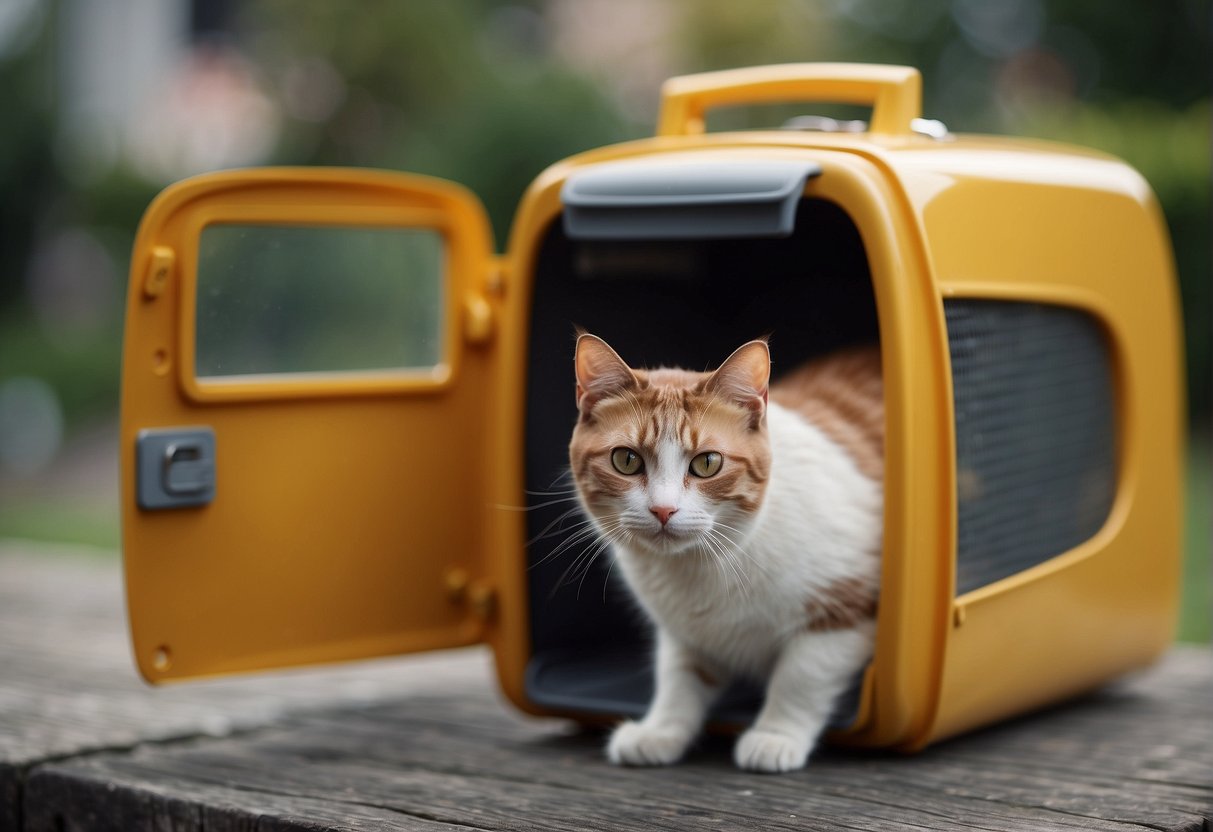Getting your cat into a carrier doesn’t have to be a stressful ordeal for either of you. Cats naturally prefer snug, enclosed spaces, but the carrier often represents fear and the unknown, especially if it only surfaces right before a trip to the vet.
When I did this with my cat Harley, I had to focus heavy on creating positive associations with the carrier. Short story, make sure it’s a safe haven! I think you can do the same, and with patience and gentle encouragement, you can turn the carrier into a cozy spot that your cat may even seek out on their own.

You can start by leaving the carrier out in an area your cat frequents, with the door open to invite exploration. A soft blanket or a familiar item of your clothing inside can make the interior more appealing.
My own experience has taught me that treats and playtime involving the carrier work wonders in reducing anxiety. A sprinkle of catnip, or a favorite toy placed inside encourages a cat to enter willingly. Remember, the goal is to make the carrier feel like an everyday comfort rather than a sign of impending stress.
Maintain this routine, and your cat’s trust in the carrier will grow. It’s all about creating a consistent, positive environment around the carrier. By feeding your cat near the carrier and occasionally placing food inside, you’ll create a routine where the carrier signifies mealtime comfort, not fear.
Preparing the Carrier

When it comes to traveling with your cat, preparing the carrier is a crucial step to ensure a stress-free experience for both of you. Proper preparation can make all the difference in how your cat perceives and adapts to the carrier.
Choosing the Right Carrier
Your first step is to select a carrier that’s suitable for your cat’s size and weight. A hard-sided carrier with a top opening is a great choice, as it’s durable and allows you to place your cat inside with less struggle. The ideal carrier size should be large enough for your cat to stand, turn around, and lie down comfortably.
- Size Guide for Carriers:
- Small Cats (up to 10 lbs): 17”L x 11”W x 11”H
- Medium Cats (10-15 lbs): 21”L x 14”W x 13”H
- Large Cats (over 15 lbs): 25”L x 19”W x 18”H
Creating a Comforting Environment
After choosing the right carrier, making it a welcoming space is your next goal. Start by placing a towel or a soft blanket inside to provide cushioning and absorb any accidents. A familiar scent can dramatically reduce stress, so consider adding an item with your scent or a blanket your cat frequently sleeps on.
- Comfort Additions:
- Cushion: Soft blanket or towel for comfort.
- Familiarity: Item with your scent (e.g., worn T-shirt).
Finally, it is often helpful to cover the carrier with a towel during transport to create a sense of security and block out overwhelming views that may startle your cat. This simple trick can have a calming effect on many cats as they journey in their crate.
Acclimating Your Cat to the Carrier
To make the experience of entering a carrier less stressful for your cat, acclimation is key. By allowing your cat to become familiar with the carrier as part of their environment, you’ll ease future travels.
Introducing the Carrier
Begin by placing the carrier in a common area where your cat spends a lot of time. Keep the carrier door open to encourage exploration. Place a familiar blanket or a piece of your clothing inside to make it more inviting. This helps bridge the gap between the unknown and the familiar, as cats often rely on scent for comfort.
Increasing Comfort and Familarity
Over time, help your cat grow more comfortable with the carrier by incorporating it into daily life. Sprinkle catnip or use a Feliway spray to create positive associations. Eventually, your cat may start to rest or play inside the carrier spontaneously. Regularly placing toys in the carrier can also turn it into a fun and rewarding space.
Using Treats and Play for Positive Experience
Treats can be highly effective in encouraging your cat to enter the carrier. Begin by placing treats near the carrier, then inside the door, and finally at the back of the carrier. You can also integrate play, using a favorite toy to lead your cat inside. Always reward them with a treat or playtime after a successful entry to reinforce the positive experience.
The Process of Getting Your Cat into the Carrier
It can be challenging to coax an unwilling cat into a carrier, but with the right techniques and a gentle approach, you can make this experience less stressful for both you and your feline friend.
Techniques for Coaxing Your Cat In
To get your cat into the carrier without a fuss, preparation is key. Start by making the carrier an inviting space. Leave it open in an area your cat frequents with a familiar blanket inside. Occasionally, place cat treats or toys in the carrier to incentivize exploration and create positive associations.
- Treat Trail: Create a path leading into the carrier using your cat’s favorite treats. Once inside, reward with additional treats.
- Purrito Technique: For more hesitant cats, wrapping them in a towel to create a “purrito” can prevent them from scratching and allows for a smooth placement into the carrier.
When using treats or the purrito method, remember to move slowly and speak in a calm, reassuring tone to reduce your cat’s stress.
Handling and Placing Your Cat in the Carrier
Once your cat is at ease with the presence of the carrier, it’s time to guide them inside. Here are some steps to follow when you’re ready to transport your cat:
- Preparing to Pick Up:
- Approach your cat calmly to avoid triggering their flight response.
- Use both hands to gently scoop them up, supporting their chest with one hand and their hindquarters with the other.
- Using the Head-First Technique:
- Carefully place your cat into the carrier head-first to prevent them from feeling trapped.
- Gently close the doors promptly after your cat is inside to prevent escape.
Always ensure that the carrier’s door is securely fastened after your cat is inside. Speak to your cat in a soothing voice throughout the process to help keep them calm. It’s important not to rush, as this can increase their anxiety and make future trips more difficult.
Ensuring a Stress-Free Journey
Before hitting the road, preparing for a smooth ride with your cat can prevent stress for both you and your furry friend. Securing the carrier and maintaining a calm environment are crucial steps for a peaceful journey, especially if you’re heading to a vet visit.
Securing the Carrier in the Vehicle
To ensure your cat’s safety during car travel, secure the carrier with a seatbelt to prevent it from shifting or toppling. Here’s how you can do it:
- Choose the Right Spot: Place the carrier on the back seat of the car, away from any airbags.
- Use the Seatbelt: Run the seatbelt through the carrier’s handles or securing points and buckle it firmly.
- Test Stability: Before driving, gently nudge the carrier to check it doesn’t move significantly.
Maintaining Calm During Travel
The key to a tranquil trip is keeping your cat relaxed. Utilize calming techniques to minimize their fear and stress:
- Cat Pheromone Spray: Apply a synthetic feline pheromone spray inside the carrier 30 minutes before travel to create a comforting environment.
- Familiar Scents: Place a blanket or cloth that smells like home inside the carrier for added reassurance.
- Controlled Environment: Keep the temperature in the car comfortable and play soft music or maintain quiet to ease anxiety.
- Motion Sickness: If your cat is prone to motion sickness, consult your vet for remedies to prevent discomfort.
- Reassurance: Speak to your cat in a calm, soothing tone if they exhibit signs of distress during the journey.

My name is James, and welcome to FAQCats!
Along with our team of cat owners, expert pet enthusiasts, and pet professionals, we aim to write engaging helpful, engaging content about cats. At FAQCats we strive to provide content that’s accurate and fun to read. Our team writes about everything related to cats; even the most complex of topics. Through extensive research and caring for our own fur-pals, we’re able to provide something cat owners worldwide will love. Have a look around, and leave us feedback anytime!

